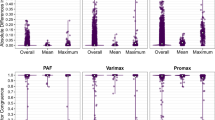Summary
Minimum Rank Factor Analysis (MRFA), see Ten Berge (1998), and Ten Berge and Kiers (1991), is a method of common factor analysis which yields, for any given covariance matrix Σ, a diagonal matrix Ψ of unique variances which are nonnegative and which entail a reduced covariance matrix Σ—Ψ which is positive semidefinite. Subject to the above constraints, MRFA minimizes the amount of common variance left unexplained when we take any fixed small number of common factors. Shapiro and Ten Berge (2002) have derived the asymptotic bias of the unexplained common variance, its variance, and also the asymptotic covariance matrix of the unique variances. The present research deals with the impact of sample size, population minimum rank, number of extracted factors and standardization of the sample covariance matrix on the bias of unexplained common variance and total common variance. Special attention was paid to situations where the asymptotic theory does not apply. The results indicate that the bias could present a practical problem only if the population minimum rank was unnaturally low or if the sample size was small.
Access this chapter
Tax calculation will be finalised at checkout
Purchases are for personal use only
Preview
Unable to display preview. Download preview PDF.
Similar content being viewed by others
References
Bucik V, Boben D, Kranjc I (1997) BFQ questionnaire and BFO rating scale for measurement of the »big five« factors of personality: Slovenian adaptation (in Slovenian). Psiholoska Obzorja 6: 5–34
Harman HH (1976) Modem factor analysis (3’d ed.). The University of Chicago press, Chicago
Ledermann W (1937) On the rank of the reduced correlation matrix in multiple-factor analysis. Psychom 2: 85–93
Shapiro A (1982) Rank-reducibility of a symmetric matrix and sampling theory of minimum trace factor analysis. Psychom 47: 187–199
Shapiro A, Ten Berge JMF (2002) Statistical inference of minimum rank factor analysis. Psychom 67: 79–94
Socan G (2000) Convergent and discriminant validity of measurement methods for speed of information-processing and related constructs. Unpublished M.A. thesis (in Slovenian). University of Ljubljana, Ljubljana
Steg FM, Vlek CM, Rooyers AJ (1993) Behavior modification to reduce automobile usage. Appreciation of the problem, readiness to change and evaluation of administrative measures: a field study (in Dutch). University of Groningen, Groningen
Ten Berge JMF (1998) Some recent developments in factor analysis and the search for proper communalities. In: Rizzi A, Vichi M, Bock H-H (eds) Advances in data science and classification. Springer, Heidelberg, pp 325–334
Ten Berge JMF, Kiers HAL (1991) A numerical approach to the approximate and the exact minimum rank of a covariance matrix. Psychom 56: 309–315
Author information
Authors and Affiliations
Editor information
Rights and permissions
Copyright information
© 2003 Springer Japan
About this paper
Cite this paper
Sočan, G., ten Berge, J.M.F. (2003). The Determinants of the Bias in Minimum Rank Factor Analysis (MRFA). In: Yanai, H., Okada, A., Shigemasu, K., Kano, Y., Meulman, J.J. (eds) New Developments in Psychometrics. Springer, Tokyo. https://doi.org/10.1007/978-4-431-66996-8_8
Download citation
DOI: https://doi.org/10.1007/978-4-431-66996-8_8
Publisher Name: Springer, Tokyo
Print ISBN: 978-4-431-66998-2
Online ISBN: 978-4-431-66996-8
eBook Packages: Springer Book Archive




